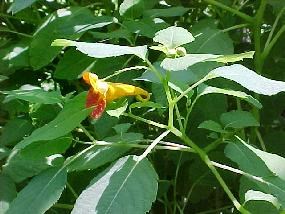
Missouri Botanical Garden
Description: Jewelweed is a tall herb (0.5-2.5 meters high) with coarsely toothed leaves and clustered showy flowers. The leaves are oval, coarsely-toothed, bluish-green (to 3.5" long) that are glaucous or whitened on the underside. Dew or rain will bead up on the leaves forming sparkling droplets which gave rise to the common name of jewelweed. Jewelweed has two kinds of flowers. The most obvious is the orange spotted flowers nodding from thin, threadlike stems. The showy flower consists of several petal-like sepals in the shape of a tube or trumpet with a spur at the end. The showy flowers are about an inch in length and are orange-yellow with mottled reddish brown spots on the inside of the trumpet. There is also a similar but different species that has yellow showy flowers (Impatiens pallida). The attractive flowers are said to resemble jewels. The other flower is a tiny petalless flower that never opens. These tiny flowers produce most of the seeds, which when ripe, explosively split open at a touch, dispersing the tiny seeds several feet in all directions, hence receiving the common name of touch-me-not. Habitat: Jewelweed ranges throughout the Other Facts: Hummingbirds and butterflies are attracted to the showy flowers to collect nectar. There are currently no threats, insect or biological, that are affecting this species. Jewelweed is commonly found growing near stinging nettle (it does sting) in the park. Native Americans used the watery plant juices to relieve itching and irritation associated with poison ivy, stinging nettle and insect bites. They have also been known to use jewelweed as an aid for dealing with dermatological, gastrointestinal, gynecological, pediatric, orthopedic, pulmonary, kidney, liver and urinary conditions. They also used jewelweed as an eye medicine, a diuretic, a burn dressing, and as a yellow/orange dye. Strausbaugh, P.D., Core, Earl L., Flora of West Virginia, Second Edition, Seneca Books Inc., Morgantown, West Virginia, p.622. Further information about jewelweed can be found: PLANTS National Database, a website supported by the Natural Resource Conservation Service. The Common Summer Wildflowers of West Virginia |
Last updated: February 26, 2015
